ICHM BBHM101: Analysis of Tourism in Japan and Travel Plan
VerifiedAdded on 2021/10/11
|7
|2288
|119
Report
AI Summary
This report examines the contemporary hospitality and tourism industry in Japan, focusing on its economic significance and cultural impact. It analyzes the push and pull factors influencing tourist decisions, highlighting the appeal of Japan's blend of tradition and modernity. The report delves into experiential travel, the characteristics of tourism products and services, and the impact of seasonality, particularly regarding peak periods and overtourism. A detailed travel plan from Adelaide to Japan is included, outlining activities, costs, and accommodation options. The analysis references various sources, including academic journals and tourism websites, to provide a comprehensive overview of the industry and its challenges.
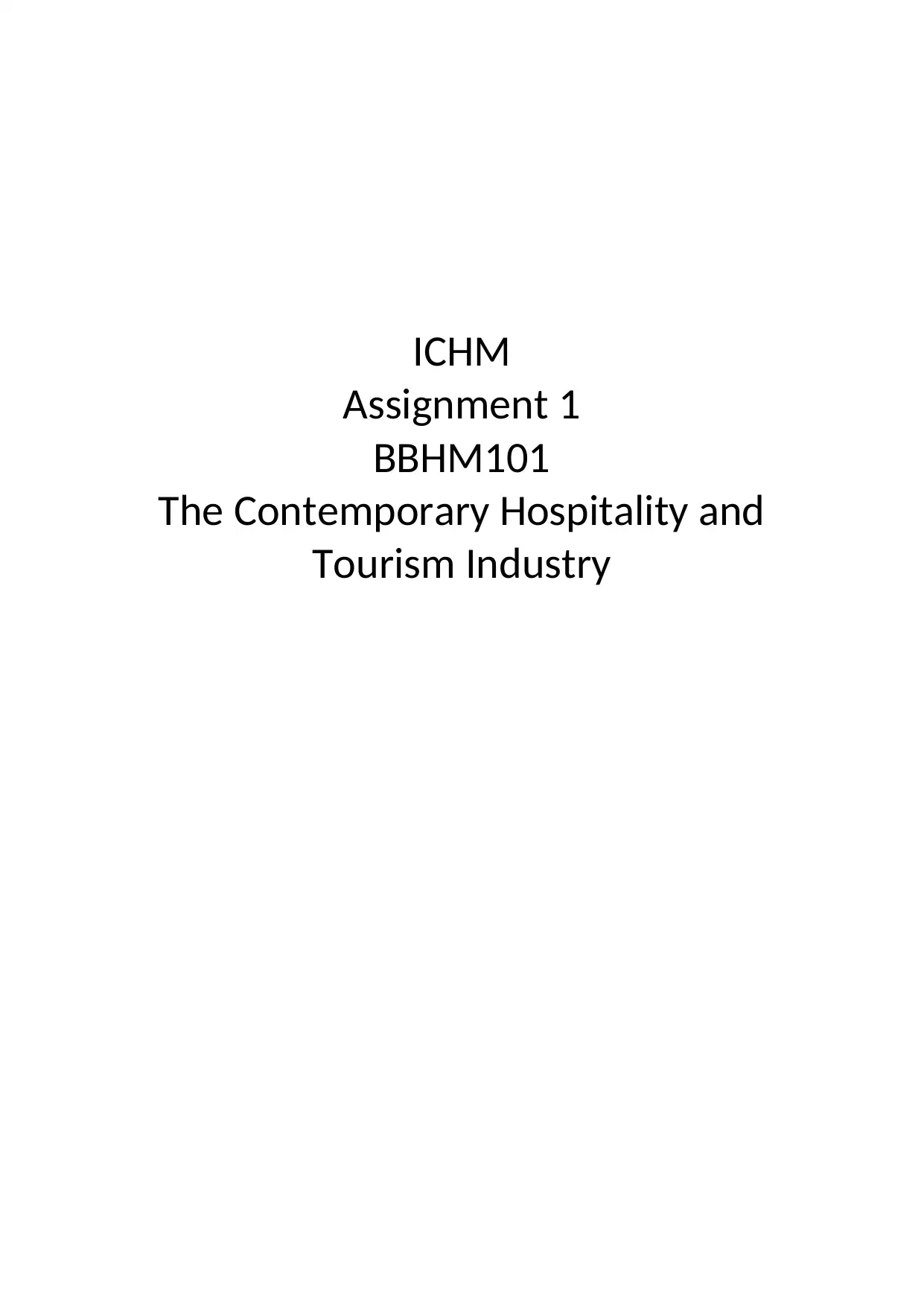
ICHM
Assignment 1
BBHM101
The Contemporary Hospitality and
Tourism Industry
Assignment 1
BBHM101
The Contemporary Hospitality and
Tourism Industry
Paraphrase This Document
Need a fresh take? Get an instant paraphrase of this document with our AI Paraphraser

Tourism in Japan is becoming an increasing contributor to the Japanese economy, with many foreign tourists
visiting the country. Up until recently, the government aimed at increasing the number of foreign visitors to
Japan to 40 million by 2020 and to 60 million by 2030, with a record high of approximately 30 million visitors in
2018 (Nikkei Asian Review, 2018). In fact, before COVID-19, Japan was experiencing record numbers of people
visiting the country (JTB Tourism Reseach & Consulting Co., 2020). Recent data analysis has discovered that
China tops foreign expenditure spending in Japan with 1.7 trillion Yen, but Australia tops the list with
expenditure per traveller with 249,000 Yen (Baseel, 2020).
Domestic tourism has a significant importance to the economy as well as in Japanese culture, with many
school groups going to amusement parks and even to different cities and islands like Hokkaido and Okinawa.
Due to the efficiency of the transport network in Japan, with high speed rail networks and as well as short term
flights to locations is it made possible. Theory states that tourist’s decision to visit are based on 4 options:
leisure, VFR (visiting friends and relatives), business and other with Japan being one of the popular
destinations to visit based on the cultural mix of tradition and modernity. Leisure is the main reason why
people travel, however, business travellers spend more when travelling.
Japan offers a wide variety of activities to do for all people. In Tokyo, you can do lots of shopping, or partake in
a wide range of themed cafes such as maid, robot and animal cafes, especially in Akihabara. The major cities in
Japan also offer amusement parks such as Disneyland and Disneysea in Tokyo and Universal Studios in Osaka.
Speaking of Osaka, it is known as Japan’s kitchen, with Dontonbori hosting many different types of cuisine for
those who feel adventurous in their eating habits. Those who prefer to spend their time away from the city can
bask in the tranquillity of Kyoto and Nara, showing more of the natural and traditional side of Japan, as well as
enjoying the wildlife.
Push and pull factors are one of the motivational theories associated with tourism and is one of the factors
that affect choice. Push factors are what travellers want, whilst pull factors are reasons why travellers want to
go to that destination. Oh (2008, pp414) states that “people travel or participate in leisure activities because
they are ‘pushed or pulled’ by forces of motivations and destination attributes’.
The main reason for travel in the travel plan (appendix 1) is for leisure activities, with the main reason for
travelling to Japan from Adelaide being a combination of reasons including relaxation, culture, events and
food. These are push factors with tourist choosing their destination being emotional reasons including
indulging, bonding or excitement. Pull factors are reasons why the location is attractive to the traveller.
The trip to go to Japan was based on the decision being that it is a new country to visit as well as hearing about
the activities and the culture associated with the Japanese way of life and experiencing new things. This relates
to the push factor motivation theory as we want to enhance relation by travelling to difference places and
visiting the country. Up until recently, the government aimed at increasing the number of foreign visitors to
Japan to 40 million by 2020 and to 60 million by 2030, with a record high of approximately 30 million visitors in
2018 (Nikkei Asian Review, 2018). In fact, before COVID-19, Japan was experiencing record numbers of people
visiting the country (JTB Tourism Reseach & Consulting Co., 2020). Recent data analysis has discovered that
China tops foreign expenditure spending in Japan with 1.7 trillion Yen, but Australia tops the list with
expenditure per traveller with 249,000 Yen (Baseel, 2020).
Domestic tourism has a significant importance to the economy as well as in Japanese culture, with many
school groups going to amusement parks and even to different cities and islands like Hokkaido and Okinawa.
Due to the efficiency of the transport network in Japan, with high speed rail networks and as well as short term
flights to locations is it made possible. Theory states that tourist’s decision to visit are based on 4 options:
leisure, VFR (visiting friends and relatives), business and other with Japan being one of the popular
destinations to visit based on the cultural mix of tradition and modernity. Leisure is the main reason why
people travel, however, business travellers spend more when travelling.
Japan offers a wide variety of activities to do for all people. In Tokyo, you can do lots of shopping, or partake in
a wide range of themed cafes such as maid, robot and animal cafes, especially in Akihabara. The major cities in
Japan also offer amusement parks such as Disneyland and Disneysea in Tokyo and Universal Studios in Osaka.
Speaking of Osaka, it is known as Japan’s kitchen, with Dontonbori hosting many different types of cuisine for
those who feel adventurous in their eating habits. Those who prefer to spend their time away from the city can
bask in the tranquillity of Kyoto and Nara, showing more of the natural and traditional side of Japan, as well as
enjoying the wildlife.
Push and pull factors are one of the motivational theories associated with tourism and is one of the factors
that affect choice. Push factors are what travellers want, whilst pull factors are reasons why travellers want to
go to that destination. Oh (2008, pp414) states that “people travel or participate in leisure activities because
they are ‘pushed or pulled’ by forces of motivations and destination attributes’.
The main reason for travel in the travel plan (appendix 1) is for leisure activities, with the main reason for
travelling to Japan from Adelaide being a combination of reasons including relaxation, culture, events and
food. These are push factors with tourist choosing their destination being emotional reasons including
indulging, bonding or excitement. Pull factors are reasons why the location is attractive to the traveller.
The trip to go to Japan was based on the decision being that it is a new country to visit as well as hearing about
the activities and the culture associated with the Japanese way of life and experiencing new things. This relates
to the push factor motivation theory as we want to enhance relation by travelling to difference places and
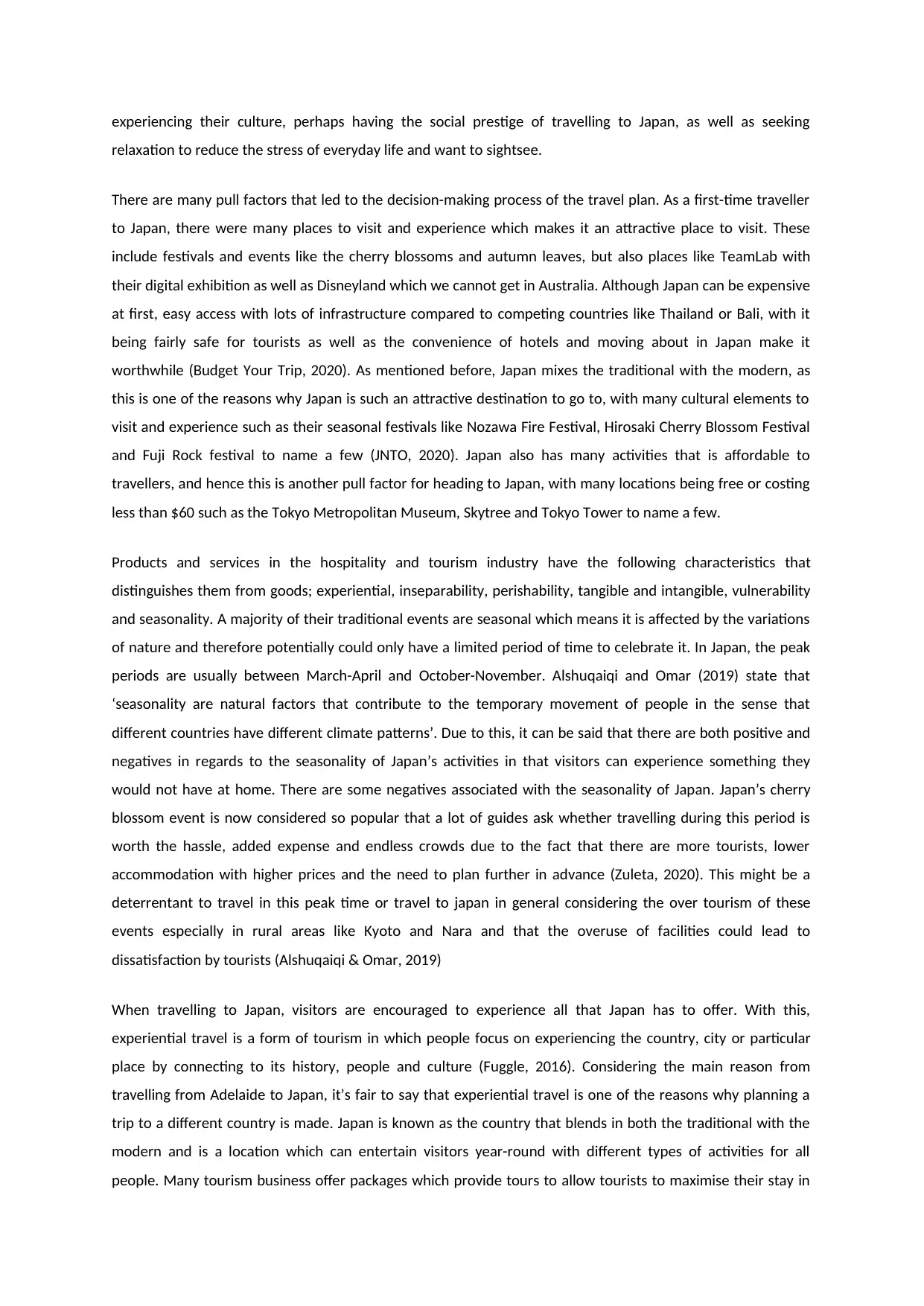
experiencing their culture, perhaps having the social prestige of travelling to Japan, as well as seeking
relaxation to reduce the stress of everyday life and want to sightsee.
There are many pull factors that led to the decision-making process of the travel plan. As a first-time traveller
to Japan, there were many places to visit and experience which makes it an attractive place to visit. These
include festivals and events like the cherry blossoms and autumn leaves, but also places like TeamLab with
their digital exhibition as well as Disneyland which we cannot get in Australia. Although Japan can be expensive
at first, easy access with lots of infrastructure compared to competing countries like Thailand or Bali, with it
being fairly safe for tourists as well as the convenience of hotels and moving about in Japan make it
worthwhile (Budget Your Trip, 2020). As mentioned before, Japan mixes the traditional with the modern, as
this is one of the reasons why Japan is such an attractive destination to go to, with many cultural elements to
visit and experience such as their seasonal festivals like Nozawa Fire Festival, Hirosaki Cherry Blossom Festival
and Fuji Rock festival to name a few (JNTO, 2020). Japan also has many activities that is affordable to
travellers, and hence this is another pull factor for heading to Japan, with many locations being free or costing
less than $60 such as the Tokyo Metropolitan Museum, Skytree and Tokyo Tower to name a few.
Products and services in the hospitality and tourism industry have the following characteristics that
distinguishes them from goods; experiential, inseparability, perishability, tangible and intangible, vulnerability
and seasonality. A majority of their traditional events are seasonal which means it is affected by the variations
of nature and therefore potentially could only have a limited period of time to celebrate it. In Japan, the peak
periods are usually between March-April and October-November. Alshuqaiqi and Omar (2019) state that
‘seasonality are natural factors that contribute to the temporary movement of people in the sense that
different countries have different climate patterns’. Due to this, it can be said that there are both positive and
negatives in regards to the seasonality of Japan’s activities in that visitors can experience something they
would not have at home. There are some negatives associated with the seasonality of Japan. Japan’s cherry
blossom event is now considered so popular that a lot of guides ask whether travelling during this period is
worth the hassle, added expense and endless crowds due to the fact that there are more tourists, lower
accommodation with higher prices and the need to plan further in advance (Zuleta, 2020). This might be a
deterrentant to travel in this peak time or travel to japan in general considering the over tourism of these
events especially in rural areas like Kyoto and Nara and that the overuse of facilities could lead to
dissatisfaction by tourists (Alshuqaiqi & Omar, 2019)
When travelling to Japan, visitors are encouraged to experience all that Japan has to offer. With this,
experiential travel is a form of tourism in which people focus on experiencing the country, city or particular
place by connecting to its history, people and culture (Fuggle, 2016). Considering the main reason from
travelling from Adelaide to Japan, it’s fair to say that experiential travel is one of the reasons why planning a
trip to a different country is made. Japan is known as the country that blends in both the traditional with the
modern and is a location which can entertain visitors year-round with different types of activities for all
people. Many tourism business offer packages which provide tours to allow tourists to maximise their stay in
relaxation to reduce the stress of everyday life and want to sightsee.
There are many pull factors that led to the decision-making process of the travel plan. As a first-time traveller
to Japan, there were many places to visit and experience which makes it an attractive place to visit. These
include festivals and events like the cherry blossoms and autumn leaves, but also places like TeamLab with
their digital exhibition as well as Disneyland which we cannot get in Australia. Although Japan can be expensive
at first, easy access with lots of infrastructure compared to competing countries like Thailand or Bali, with it
being fairly safe for tourists as well as the convenience of hotels and moving about in Japan make it
worthwhile (Budget Your Trip, 2020). As mentioned before, Japan mixes the traditional with the modern, as
this is one of the reasons why Japan is such an attractive destination to go to, with many cultural elements to
visit and experience such as their seasonal festivals like Nozawa Fire Festival, Hirosaki Cherry Blossom Festival
and Fuji Rock festival to name a few (JNTO, 2020). Japan also has many activities that is affordable to
travellers, and hence this is another pull factor for heading to Japan, with many locations being free or costing
less than $60 such as the Tokyo Metropolitan Museum, Skytree and Tokyo Tower to name a few.
Products and services in the hospitality and tourism industry have the following characteristics that
distinguishes them from goods; experiential, inseparability, perishability, tangible and intangible, vulnerability
and seasonality. A majority of their traditional events are seasonal which means it is affected by the variations
of nature and therefore potentially could only have a limited period of time to celebrate it. In Japan, the peak
periods are usually between March-April and October-November. Alshuqaiqi and Omar (2019) state that
‘seasonality are natural factors that contribute to the temporary movement of people in the sense that
different countries have different climate patterns’. Due to this, it can be said that there are both positive and
negatives in regards to the seasonality of Japan’s activities in that visitors can experience something they
would not have at home. There are some negatives associated with the seasonality of Japan. Japan’s cherry
blossom event is now considered so popular that a lot of guides ask whether travelling during this period is
worth the hassle, added expense and endless crowds due to the fact that there are more tourists, lower
accommodation with higher prices and the need to plan further in advance (Zuleta, 2020). This might be a
deterrentant to travel in this peak time or travel to japan in general considering the over tourism of these
events especially in rural areas like Kyoto and Nara and that the overuse of facilities could lead to
dissatisfaction by tourists (Alshuqaiqi & Omar, 2019)
When travelling to Japan, visitors are encouraged to experience all that Japan has to offer. With this,
experiential travel is a form of tourism in which people focus on experiencing the country, city or particular
place by connecting to its history, people and culture (Fuggle, 2016). Considering the main reason from
travelling from Adelaide to Japan, it’s fair to say that experiential travel is one of the reasons why planning a
trip to a different country is made. Japan is known as the country that blends in both the traditional with the
modern and is a location which can entertain visitors year-round with different types of activities for all
people. Many tourism business offer packages which provide tours to allow tourists to maximise their stay in
⊘ This is a preview!⊘
Do you want full access?
Subscribe today to unlock all pages.

Trusted by 1+ million students worldwide
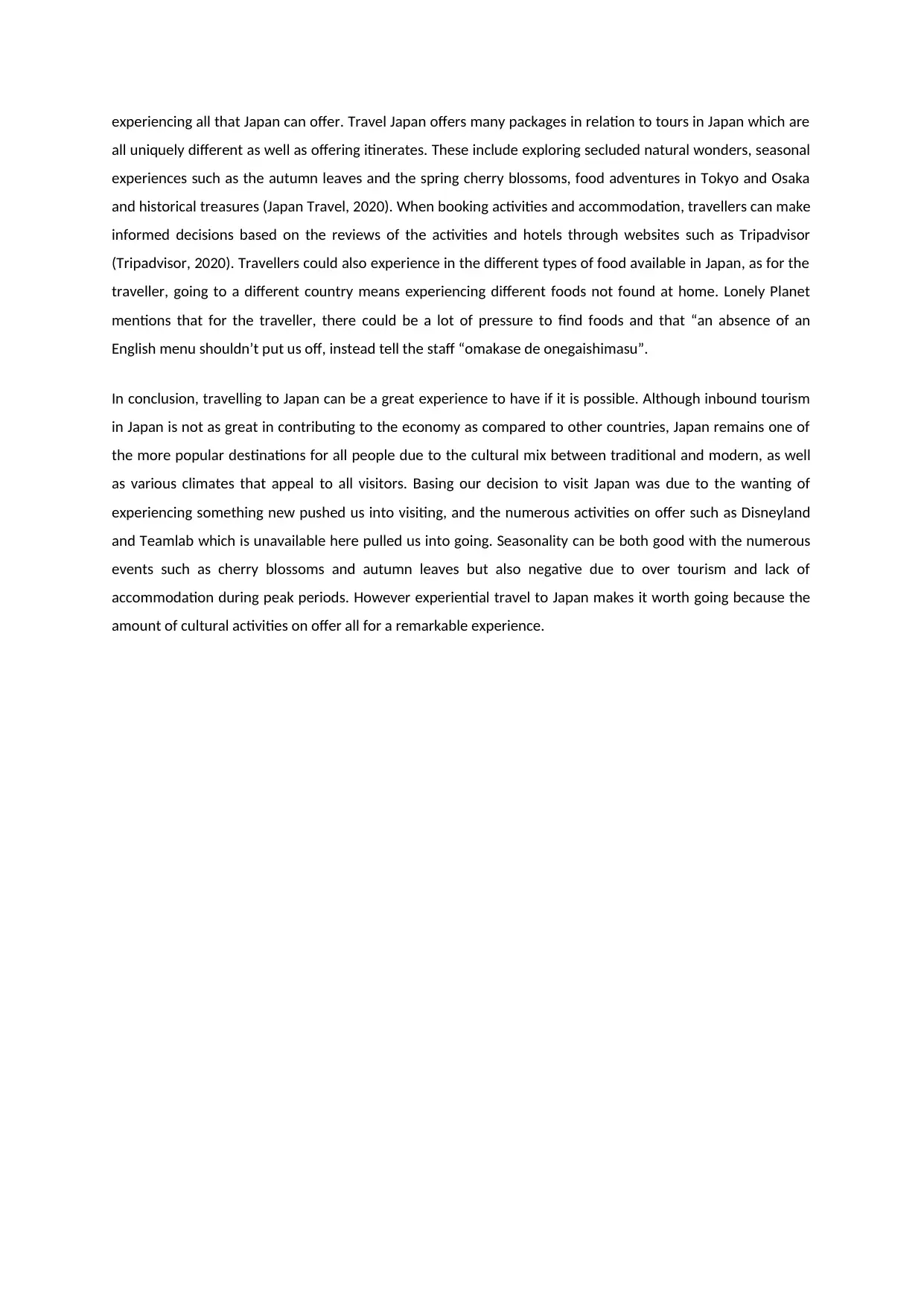
experiencing all that Japan can offer. Travel Japan offers many packages in relation to tours in Japan which are
all uniquely different as well as offering itinerates. These include exploring secluded natural wonders, seasonal
experiences such as the autumn leaves and the spring cherry blossoms, food adventures in Tokyo and Osaka
and historical treasures (Japan Travel, 2020). When booking activities and accommodation, travellers can make
informed decisions based on the reviews of the activities and hotels through websites such as Tripadvisor
(Tripadvisor, 2020). Travellers could also experience in the different types of food available in Japan, as for the
traveller, going to a different country means experiencing different foods not found at home. Lonely Planet
mentions that for the traveller, there could be a lot of pressure to find foods and that “an absence of an
English menu shouldn’t put us off, instead tell the staff “omakase de onegaishimasu”.
In conclusion, travelling to Japan can be a great experience to have if it is possible. Although inbound tourism
in Japan is not as great in contributing to the economy as compared to other countries, Japan remains one of
the more popular destinations for all people due to the cultural mix between traditional and modern, as well
as various climates that appeal to all visitors. Basing our decision to visit Japan was due to the wanting of
experiencing something new pushed us into visiting, and the numerous activities on offer such as Disneyland
and Teamlab which is unavailable here pulled us into going. Seasonality can be both good with the numerous
events such as cherry blossoms and autumn leaves but also negative due to over tourism and lack of
accommodation during peak periods. However experiential travel to Japan makes it worth going because the
amount of cultural activities on offer all for a remarkable experience.
all uniquely different as well as offering itinerates. These include exploring secluded natural wonders, seasonal
experiences such as the autumn leaves and the spring cherry blossoms, food adventures in Tokyo and Osaka
and historical treasures (Japan Travel, 2020). When booking activities and accommodation, travellers can make
informed decisions based on the reviews of the activities and hotels through websites such as Tripadvisor
(Tripadvisor, 2020). Travellers could also experience in the different types of food available in Japan, as for the
traveller, going to a different country means experiencing different foods not found at home. Lonely Planet
mentions that for the traveller, there could be a lot of pressure to find foods and that “an absence of an
English menu shouldn’t put us off, instead tell the staff “omakase de onegaishimasu”.
In conclusion, travelling to Japan can be a great experience to have if it is possible. Although inbound tourism
in Japan is not as great in contributing to the economy as compared to other countries, Japan remains one of
the more popular destinations for all people due to the cultural mix between traditional and modern, as well
as various climates that appeal to all visitors. Basing our decision to visit Japan was due to the wanting of
experiencing something new pushed us into visiting, and the numerous activities on offer such as Disneyland
and Teamlab which is unavailable here pulled us into going. Seasonality can be both good with the numerous
events such as cherry blossoms and autumn leaves but also negative due to over tourism and lack of
accommodation during peak periods. However experiential travel to Japan makes it worth going because the
amount of cultural activities on offer all for a remarkable experience.
Paraphrase This Document
Need a fresh take? Get an instant paraphrase of this document with our AI Paraphraser
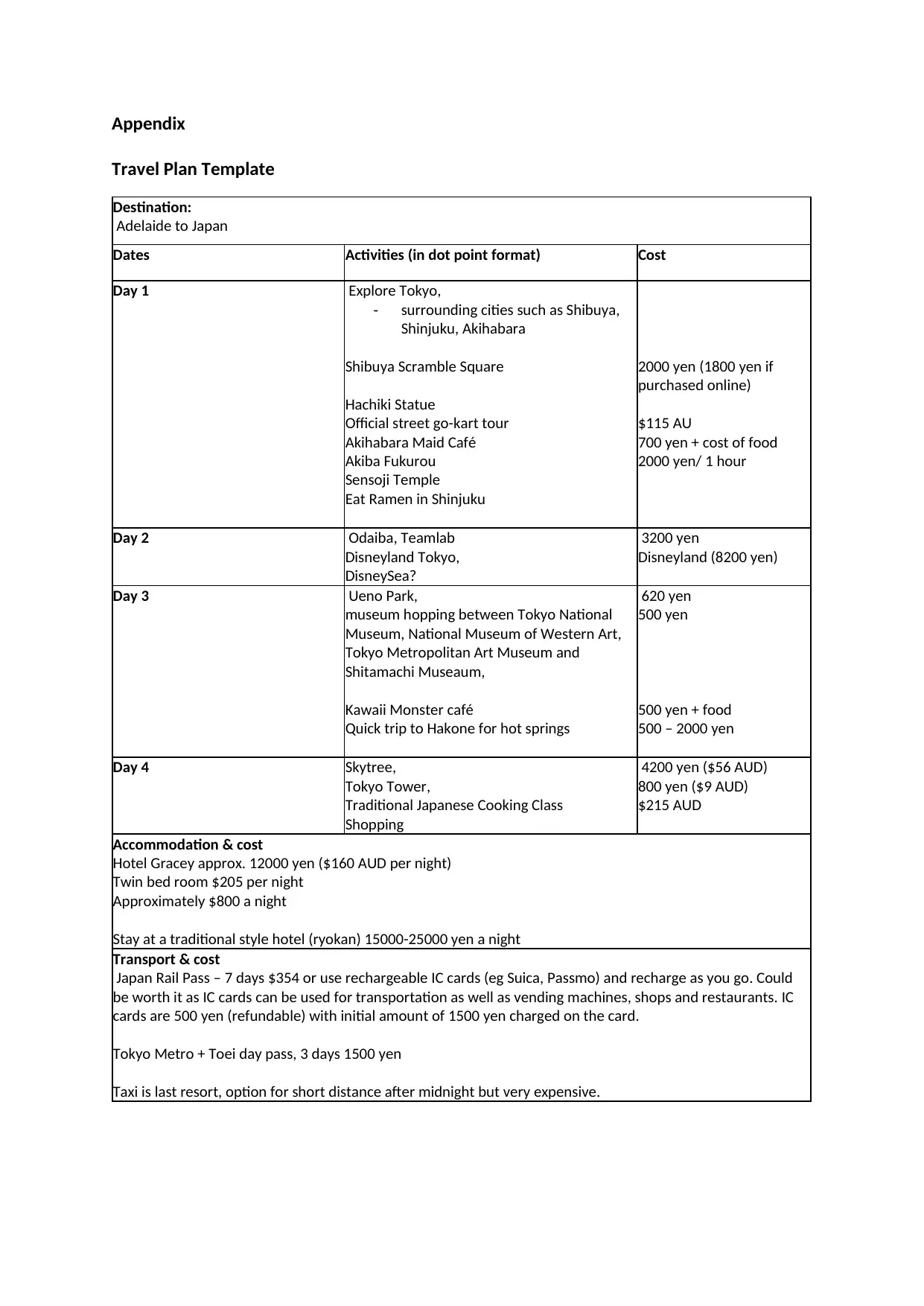
Appendix
Travel Plan Template
Destination:
Adelaide to Japan
Dates Activities (in dot point format) Cost
Day 1 Explore Tokyo,
- surrounding cities such as Shibuya,
Shinjuku, Akihabara
Shibuya Scramble Square
Hachiki Statue
Official street go-kart tour
Akihabara Maid Café
Akiba Fukurou
Sensoji Temple
Eat Ramen in Shinjuku
2000 yen (1800 yen if
purchased online)
$115 AU
700 yen + cost of food
2000 yen/ 1 hour
Day 2 Odaiba, Teamlab
Disneyland Tokyo,
DisneySea?
3200 yen
Disneyland (8200 yen)
Day 3 Ueno Park,
museum hopping between Tokyo National
Museum, National Museum of Western Art,
Tokyo Metropolitan Art Museum and
Shitamachi Museaum,
Kawaii Monster café
Quick trip to Hakone for hot springs
620 yen
500 yen
500 yen + food
500 – 2000 yen
Day 4 Skytree,
Tokyo Tower,
Traditional Japanese Cooking Class
Shopping
4200 yen ($56 AUD)
800 yen ($9 AUD)
$215 AUD
Accommodation & cost
Hotel Gracey approx. 12000 yen ($160 AUD per night)
Twin bed room $205 per night
Approximately $800 a night
Stay at a traditional style hotel (ryokan) 15000-25000 yen a night
Transport & cost
Japan Rail Pass – 7 days $354 or use rechargeable IC cards (eg Suica, Passmo) and recharge as you go. Could
be worth it as IC cards can be used for transportation as well as vending machines, shops and restaurants. IC
cards are 500 yen (refundable) with initial amount of 1500 yen charged on the card.
Tokyo Metro + Toei day pass, 3 days 1500 yen
Taxi is last resort, option for short distance after midnight but very expensive.
Travel Plan Template
Destination:
Adelaide to Japan
Dates Activities (in dot point format) Cost
Day 1 Explore Tokyo,
- surrounding cities such as Shibuya,
Shinjuku, Akihabara
Shibuya Scramble Square
Hachiki Statue
Official street go-kart tour
Akihabara Maid Café
Akiba Fukurou
Sensoji Temple
Eat Ramen in Shinjuku
2000 yen (1800 yen if
purchased online)
$115 AU
700 yen + cost of food
2000 yen/ 1 hour
Day 2 Odaiba, Teamlab
Disneyland Tokyo,
DisneySea?
3200 yen
Disneyland (8200 yen)
Day 3 Ueno Park,
museum hopping between Tokyo National
Museum, National Museum of Western Art,
Tokyo Metropolitan Art Museum and
Shitamachi Museaum,
Kawaii Monster café
Quick trip to Hakone for hot springs
620 yen
500 yen
500 yen + food
500 – 2000 yen
Day 4 Skytree,
Tokyo Tower,
Traditional Japanese Cooking Class
Shopping
4200 yen ($56 AUD)
800 yen ($9 AUD)
$215 AUD
Accommodation & cost
Hotel Gracey approx. 12000 yen ($160 AUD per night)
Twin bed room $205 per night
Approximately $800 a night
Stay at a traditional style hotel (ryokan) 15000-25000 yen a night
Transport & cost
Japan Rail Pass – 7 days $354 or use rechargeable IC cards (eg Suica, Passmo) and recharge as you go. Could
be worth it as IC cards can be used for transportation as well as vending machines, shops and restaurants. IC
cards are 500 yen (refundable) with initial amount of 1500 yen charged on the card.
Tokyo Metro + Toei day pass, 3 days 1500 yen
Taxi is last resort, option for short distance after midnight but very expensive.

Food & Beverage & cost
Many food options available, ranging from cheap to expensive
Shin Udon in Shinjuku (1250 yen)
Cheap restaurants can have full meals ranging between 500 to 100 yen (ramen, soba, udon, donburi, curry,
bibimbap). Found usually in train stations and business areas.
Average restaurant cost between 1000 and 3000 yen, lunch sets are available during lunch areas (1000 yen)
Bento boxes in convenience stores and department stores.
Many food options available, ranging from cheap to expensive
Shin Udon in Shinjuku (1250 yen)
Cheap restaurants can have full meals ranging between 500 to 100 yen (ramen, soba, udon, donburi, curry,
bibimbap). Found usually in train stations and business areas.
Average restaurant cost between 1000 and 3000 yen, lunch sets are available during lunch areas (1000 yen)
Bento boxes in convenience stores and department stores.
⊘ This is a preview!⊘
Do you want full access?
Subscribe today to unlock all pages.

Trusted by 1+ million students worldwide
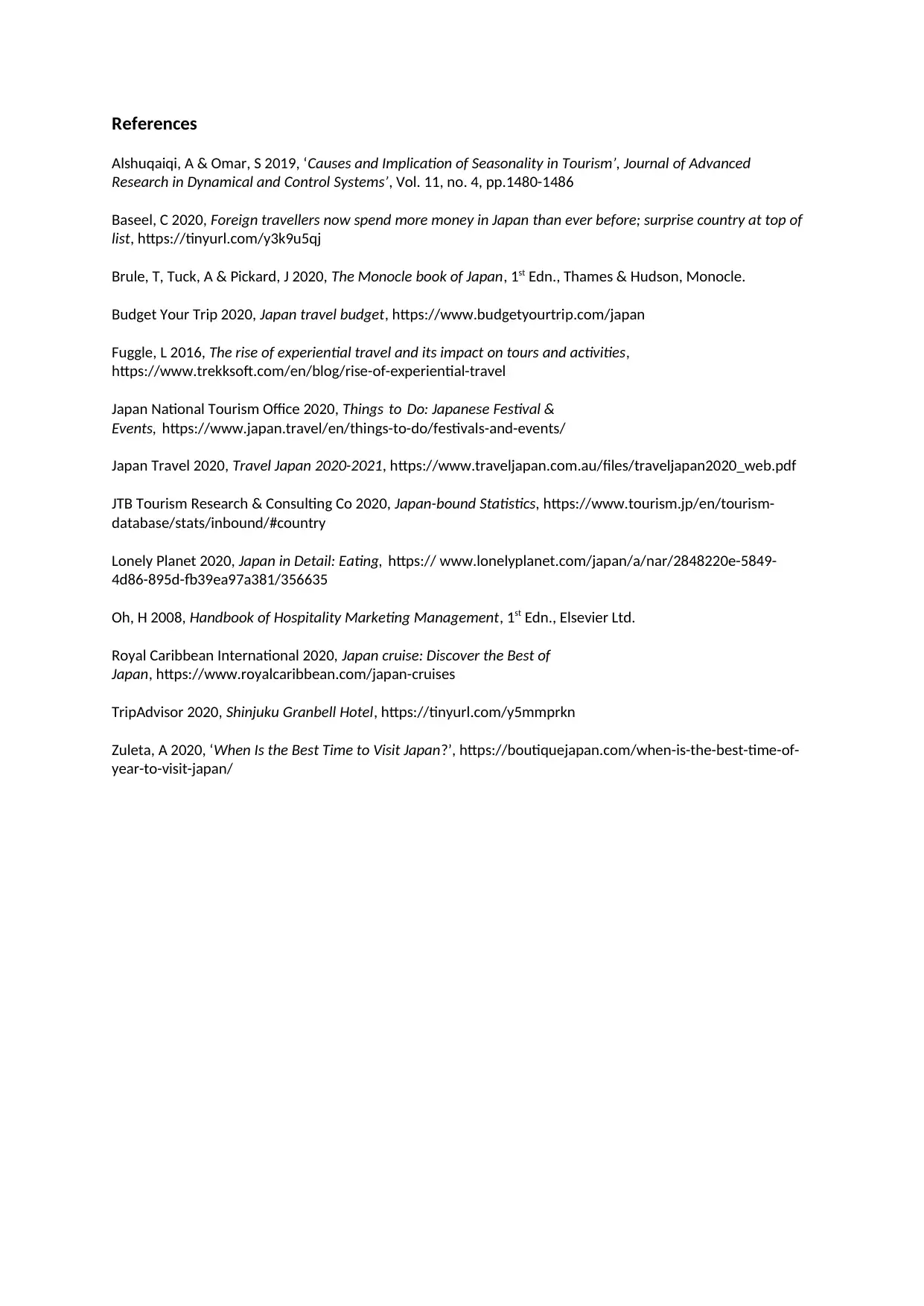
References
Alshuqaiqi, A & Omar, S 2019, ‘Causes and Implication of Seasonality in Tourism’, Journal of Advanced
Research in Dynamical and Control Systems’, Vol. 11, no. 4, pp.1480-1486
Baseel, C 2020, Foreign travellers now spend more money in Japan than ever before; surprise country at top of
list, https://tinyurl.com/y3k9u5qj
Brule, T, Tuck, A & Pickard, J 2020, The Monocle book of Japan, 1st Edn., Thames & Hudson, Monocle.
Budget Your Trip 2020, Japan travel budget, https://www.budgetyourtrip.com/japan
Fuggle, L 2016, The rise of experiential travel and its impact on tours and activities,
https://www.trekksoft.com/en/blog/rise-of-experiential-travel
Japan National Tourism Office 2020, Things to Do: Japanese Festival &
Events, https://www.japan.travel/en/things-to-do/festivals-and-events/
Japan Travel 2020, Travel Japan 2020-2021, https://www.traveljapan.com.au/files/traveljapan2020_web.pdf
JTB Tourism Research & Consulting Co 2020, Japan-bound Statistics, https://www.tourism.jp/en/tourism-
database/stats/inbound/#country
Lonely Planet 2020, Japan in Detail: Eating, https:// www.lonelyplanet.com/japan/a/nar/2848220e-5849-
4d86-895d-fb39ea97a381/356635
Oh, H 2008, Handbook of Hospitality Marketing Management, 1st Edn., Elsevier Ltd.
Royal Caribbean International 2020, Japan cruise: Discover the Best of
Japan, https://www.royalcaribbean.com/japan-cruises
TripAdvisor 2020, Shinjuku Granbell Hotel, https://tinyurl.com/y5mmprkn
Zuleta, A 2020, ‘When Is the Best Time to Visit Japan?’, https://boutiquejapan.com/when-is-the-best-time-of-
year-to-visit-japan/
Alshuqaiqi, A & Omar, S 2019, ‘Causes and Implication of Seasonality in Tourism’, Journal of Advanced
Research in Dynamical and Control Systems’, Vol. 11, no. 4, pp.1480-1486
Baseel, C 2020, Foreign travellers now spend more money in Japan than ever before; surprise country at top of
list, https://tinyurl.com/y3k9u5qj
Brule, T, Tuck, A & Pickard, J 2020, The Monocle book of Japan, 1st Edn., Thames & Hudson, Monocle.
Budget Your Trip 2020, Japan travel budget, https://www.budgetyourtrip.com/japan
Fuggle, L 2016, The rise of experiential travel and its impact on tours and activities,
https://www.trekksoft.com/en/blog/rise-of-experiential-travel
Japan National Tourism Office 2020, Things to Do: Japanese Festival &
Events, https://www.japan.travel/en/things-to-do/festivals-and-events/
Japan Travel 2020, Travel Japan 2020-2021, https://www.traveljapan.com.au/files/traveljapan2020_web.pdf
JTB Tourism Research & Consulting Co 2020, Japan-bound Statistics, https://www.tourism.jp/en/tourism-
database/stats/inbound/#country
Lonely Planet 2020, Japan in Detail: Eating, https:// www.lonelyplanet.com/japan/a/nar/2848220e-5849-
4d86-895d-fb39ea97a381/356635
Oh, H 2008, Handbook of Hospitality Marketing Management, 1st Edn., Elsevier Ltd.
Royal Caribbean International 2020, Japan cruise: Discover the Best of
Japan, https://www.royalcaribbean.com/japan-cruises
TripAdvisor 2020, Shinjuku Granbell Hotel, https://tinyurl.com/y5mmprkn
Zuleta, A 2020, ‘When Is the Best Time to Visit Japan?’, https://boutiquejapan.com/when-is-the-best-time-of-
year-to-visit-japan/
1 out of 7
Related Documents
Your All-in-One AI-Powered Toolkit for Academic Success.
+13062052269
info@desklib.com
Available 24*7 on WhatsApp / Email
![[object Object]](/_next/static/media/star-bottom.7253800d.svg)
Unlock your academic potential
Copyright © 2020–2025 A2Z Services. All Rights Reserved. Developed and managed by ZUCOL.





